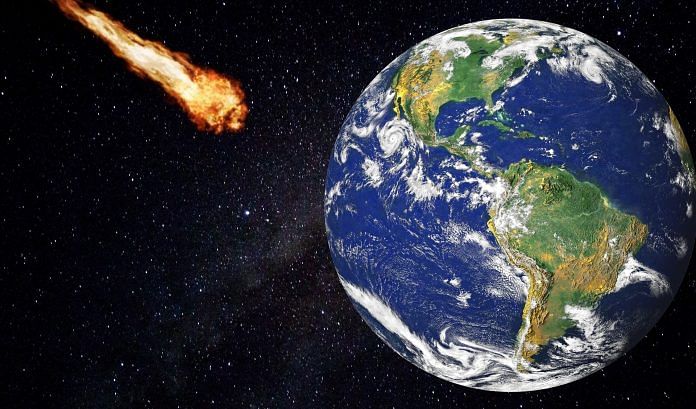New Delhi: Two students from IIT Bombay have discovered the asteroid known to have flown closest past Earth this week.
Dubbed 2020 QG, the asteroid passed 2,950 km above the southern Indian Ocean in the early hours of 16 August. It measured roughly 10 to 20 feet across, which is is too small to pose any threat to Earth. Even if the asteroid had been on track to hit Earth, it would have turned into a fireball and broken up in the planet’s atmosphere.
IIT Bombay students Kunal Deshmukh and Kritti Sharma discovered this object while scanning through the data from the Zwicky Transient Facility (ZTF), a robotic sky-scanning survey camera in California.
The asteroid 2020 QG is now the closest known asteroid to fly by Earth without impacting the planet. The previous known record-holder is 2011 CQ1, discovered in the year 2011, which passed above Earth about 2,500 km higher than 2020 QG. More on Indian Express.
Centre of Milky Way shooting out dense, cold gas ‘like bullets’
Scientists have found that the centre of our Milky Way is shooting out dense, cold gas like bullets, but its origin remains a mystery.
When a galaxy pushes out a lot of mass, the material could form new stars. However, if too much mass is lost into space, the galaxy will not be able to form new stars anymore.
It is unclear whether the massive black hole at the centre of the galaxy has expelled the gas or if it was blown out by the thousands of stars at the centre of the galaxy. More on Live Science.
Also read: Seismologists discover a ‘boomerang earthquake’ that occurred under water in 2016
Fossil of an ichthyosaur shows it devoured prey as big as itself
Paleontologists in China uncovered a nearly complete skeleton of an ichthyosaur (a giant, dolphin-like marine reptile) with remains of a 4m-long, lizard-like reptile in its stomach.
This is one of the longest fossils ever found in the stomach of a prehistoric marine reptile. The ichthyosaur itself was about 5m long, which meant that for its last meal, it tried to devour prey that was almost its own size.
Researchers believe the ichthyosaur may have died almost as soon as it devoured the prey known as thalattosaur. The fossil provides the oldest direct evidence of megapredation, which is when large animals consumed others as large or larger than humans.
The researchers found that the thalattosaur’s neck was broken, but its head and limbs were attached to its body in the stomach of the ichthyosaur, while a disconnected tail was found many yards away, leading the researchers to believe it was ripped off and left behind by a predator. More on ABC 17.
Greenland Ice Sheet lost record amount of mass in 2019
The Greenland Ice Sheet lost about 532 billion metric tonnes of its ice in 2019, which sets a new record, scientists found last week. The loss equates to an average global sea-level rise of 1.5 mm.
To determine the extent of ice loss, researchers evaluated satellite data from the GRACE mission, and its successor mission, GRACE Follow-On. The satellites provided highly accurate measurements that were used to create monthly maps of Earth’s gravity. The redistribution of the masses, caused by ice losses in the oceans, leads to changes in Earth’s gravitational forces.
The researchers compared the satellite data with regional climate models that are specially designed to calculate the snowfall and the melting of the ice sheet.
The team found that after two years characterised by low loss of mass in 2017 and 2018, the ice sheet is now heading toward increasing mass losses. The five years with the greatest losses all occurred in the last decade. The ice loss in 2019 exceeded the increase due to snowfall by over 80 per cent.
According to the researchers, the ice loss has exceeded all annual losses since 1948. More on The Guardian.
Floating volcanic rocks could help Australia’s Great Barrier Reef
A giant pumice raft, that formed as a result of an underwater volcanic eruption last year in August in the Southern Pacific ocean, has begun to arrive on the Australian coast after completing a 3,000 km journey.
Loaded with organisms that can help build reefs, the lightweight bubble-rich rock can provide a fresh lease of life to Australia’s iconic Great Barrier Reef, which has suffered several mass bleaching events over the last five years, causing severe damage to corals in the area as well as the marine ecosystems.
Pumice forms when frothing magma cools very rapidly, causing hard rocks to form with air bubbles trapped in them. Organisms attached to these rocks get transported across the oceans and deposited on the Australian coast, where they provide a boost for reef building.
Researchers say that this process of the pumice raft boosting the Great Barrier Reef is a “very ancient process”. It allows for marine life to be transferred around the Earth. More on 7News.
Also read: First-ever image of new planetary system could hold clues to our own evolution



